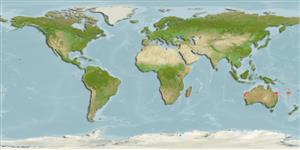Actinopterygii (ray-finned fishes) >
Mugiliformes (Mullets) >
Mugilidae (Mullets)
Etymology: Chelon: Greek, chelone = turtle (Ref. 45335).
Environment / Climate / Range
Ecology
Marine; freshwater; brackish; reef-associated; catadromous (Ref. 46888); depth range 0 - 5 m (Ref. 86942). Subtropical, preferred ?; 20°S - 30°S
Indo-Pacific: East Africa to the Marquesan Islands, north to the Philippines and the South China Sea, south to Tonga and tropical Australia.
Size / Weight / Age
Maturity: Lm ? range ? - ? cm
Max length : 30.0 cm SL male/unsexed; (Ref. 9812); common length : 18.0 cm SL male/unsexed; (Ref. 9812)
School in shallow coastal waters; enter lagoons, estuaries, and rivers to feed (Ref. 9812). Feed on plant detritus, microalgae, minute benthic organisms, and organic matter in sand and mud; juveniles feed on planktonic algae (Ref. 9812). Oviparous, eggs are pelagic and non-adhesive (Ref. 205). Also caught with stakenets and is marketed fresh (Ref. 9812).
Life cycle and mating behavior
Maturity | Reproduction | Spawning | Eggs | Fecundity | Larvae
Myers, R.F., 1991. Micronesian reef fishes. Second Ed. Coral Graphics, Barrigada, Guam. 298 p. (Ref. 1602)
IUCN Red List Status (Ref. 115185)
CITES (Ref. 94142)
Not Evaluated
Threat to humans
Harmless
Human uses
Fisheries: commercial
More information
Common namesSynonymsMetabolismPredatorsEcotoxicologyReproductionMaturitySpawningFecundityEggsEgg development
ReferencesAquacultureAquaculture profileStrainsGeneticsAllele frequenciesHeritabilityDiseasesProcessingMass conversion
Tools
Special reports
Download XML
Internet sources
